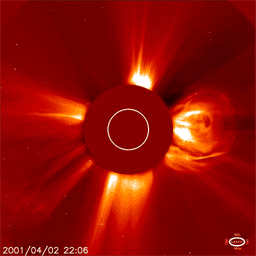|
INTRODUCTION
MAGNETIC FIELDS
CMES AND FLARES
MAGNETIC MODELING
FORECASTERS
HOME
|
Coronal Mass Ejections

Image Credit: SOHO
|
The image lo the left is a visible light image of a coronal mass ejection (CME) erupting off the west limb
of the Sun. CMEs are large bubbles of magnetized gas which may take several hours to erupt into space. The
image below was taken by the LASCO coronagraph on the SOHO spacecraft. A coronagraph images the corona by
blocking out the disk of the Sun with an occulting disk, much like the moon does during an eclipse. In the
LASCO image the location of the Sun's disk is represented by the white circle at the center. Knowing this,
you can see just how large a CME event is! Click on the image to see a movie of several coronal mass ejections.
In the movie you'll notice a build up of white specks in the image, this is caused by energetic particles,
associated with the CME, as they hit the SOHO satellite's detectors.
|
When a CME erupts from the Sun, magnetized plasma is hurled into space interrupting the steady solar wind. The ejected coronal material moves through the solar wind, creating a disturbance. This
disturbance may include a shock wave that moves ahead of the CME, accelerating some solar wind particles to high energies as it moves. This process adds to any other energetic particles that may be
present from an associated flare. If the CME reaches the Earth there can be significant consequences to communications, satellite operations and power generation. International Space Station astronauts
must be aware of extra vehicular activities (EVAs) during these "magnetic storms" because of the possible radiation doses from the energetic particles, and aircraft flying polar routes may choose to delay
their departure. But, there is also beauty in these events in the awesome polar region auroras that occur when the solar wind disturbance reaches us. The aurora image was taken from the Space
Shuttle.
The speed at which a CME leaves the Sun can vary, but typically the brundt of the material reaches earth in 3 to 4 days. By clicking on the image below you'll see an animated movie of a CME as it
traveles towards Earth. By studying how changes in the Sun's magnetic field might lead to the eruption of a CME, scientists are working to improve their ability at predicting space weather storms.

Image Credit: SOHO
PAGE:
1
2
3
|

